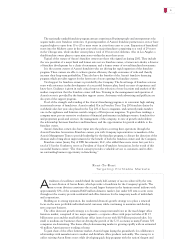Aarons 2000 Annual Report Download - page 21
Download and view the complete annual report
Please find page 21 of the 2000 Aarons annual report below. You can navigate through the pages in the report by either clicking on the pages listed below, or by using the keyword search tool below to find specific information within the annual report.
19
Notes to Consolidated
Financial Statements
As of December 31, 2000 and 1999, and for the Years Ended December 31, 2000, 1999 and 1998.
Note A: Summary of Significant
Accounting Policies
Basis of Presentation — The consolidated financial statements include the accounts of Aaron Rents, Inc.
and its wholly-owned subsidiaries (the Company). All significant intercompany accounts and transactions
have been eliminated. The preparation of the Company’s consolidated financial statements in conformity
with generally accepted accounting principles requires management to make estimates and assumptions
that affect the amounts reported in these financial statements and accompanying notes. Actual results
could differ from those estimates.
Line of Business — The Company is engaged in the business of renting and selling residential and
office furniture, consumer electronics, appliances and other merchandise throughout the U.S. and Puerto
Rico. The Company manufactures furniture principally for its rental and sales operations.
Rental Merchandise consists primarily of residential and office furniture, consumer electronics, appliances
and other merchandise and is recorded at cost. The sales & lease ownership division depreciates merchan-
dise over the agreement period, generally 12 months, when on rent, and 36 months, when not on rent, to
a 0% salvage value. This method is similar to a method referred to as the income forecasting method in
the rental purchase industry. The rent-to-rent division depreciates merchandise over its estimated useful
life which ranges from 6 months to 60 months, net of its salvage value which ranges from 0% to 60%.
All rental merchandise is available for rental and sale.
Property, Plant and Equipment are recorded at cost. Depreciation and amortization are computed on a
straight-line basis over the estimated useful lives of the respective assets, which are from 8 to 27 years for
buildings and improvements and from 1 to 5 years for other depreciable property and equipment. Gains
and losses related to dispositions and retirements are expensed as incurred. Maintenance and repairs are
also expensed as incurred; renewals and betterments are capitalized.
Deferred Income Taxes are provided for temporary differences between the amounts of assets and
liabilities for financial and tax reporting purposes. Such temporary differences arise principally from the
use of accelerated depreciation methods on rental merchandise for tax purposes.
Cost of Sales includes the net book value of merchandise sold, primarily using specific identification
in the sales & lease ownership division and first-in, first-out in the rent-to-rent division. It is not prac-
ticable to allocate operating expenses between selling and rental operations.
Shipping and Handling Costs — Shipping and handling costs are classified as operating expenses in
the accompanying consolidated statements of operations and totaled approximately $17,397,000 in 2000,
$15,129,000 in 1999 and $13,458,000 in 1998.
Advertising — The Company expenses advertising costs as incurred. Such costs aggregated $11,937,000
in 2000, $12,496,000 in 1999, and $11,523,000 in 1998.
Stock Based Compensation — The Company has elected to follow Accounting Principles Board
Opinion No. 25, Accounting for Stock Issued to Employees and related Interpretations in accounting for its
employee stock options and adopted the disclosure-only provisions of Statement of Financial Accounting
Standards No. 123, Accounting for Stock Based Compensation (FAS 123). The Company grants stock
options for a fixed number of shares to employees with an exercise price equal to the fair value of the
shares at the date of grant and, accordingly, recognizes no compensation expense for the stock option
grants. Income tax benefits resulting from stock option exercises credited to additional paid-in capital
totaled approximately $540,000, $867,000 and $830,000, in 2000, 1999 and 1998, respectively.
Excess Costs over Net Assets Acquired — Goodwill is amortized on a straight-line basis over a period
of twenty years. Long-lived assets, including goodwill, are periodically reviewed for impairment based on
an assessment of future operations. The Company records impairment losses on long-lived assets used in
operations when indicators of impairment are present and the undiscounted cash flows estimated to be
generated by those assets are less than the assets’ carrying amount. Measurement of an impairment loss
is based on the estimated fair value of the asset.
Fair Value of Financial Instruments — The carrying amounts reflected in the consolidated balance
sheets for cash, accounts receivable, bank and other debt approximate their respective fair values.
Revenue Recognition — Rental revenues are recognized as revenue in the month they are due. Rental
payments received prior to the month due are recorded as deferred rental revenue. Revenues from the sale
of residential and office furniture and other merchandise are recognized at the time of shipment.
























